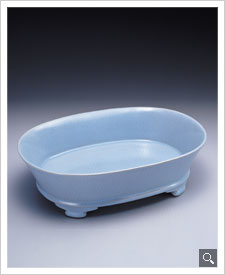During the Song, Jin and Yuan dynasties from the tenth to fourteenth centuries, the firing of stoneware are widespread. Famous stonewares were named after the locations at which they were produced. Various kilns in different places came to establish their own independent styles as each excelled in the forms, glazes, skills for decorating and techniques of production for which they became known.
The centers of white-ware production during this period were the Ding kilns located in Hebei province of the north and the Jingdezhen kilns in Jiangxi province of the south. The former produced an ivory-white glaze while the latter created shadowy blue glaze. Wares from both places were known for their fluidly-carved decorative motifs and patterns created by impressing molds onto the clay body. As for black ware, Jian ware produced in Fujian province enjoyed the greatest reputation, with the crystallized streaks in the glaze appearing like the hairs of a hare. The center of multi-colored ware production was at the Jun kilns in Henan province, the glazes exhibiting various shades of blues and violets on milky-green base colors. Furthermore, many kilns also applied various ferric oxides as a coloring agent, producing celadons in different shades of light green or blue. For example, Yaozhou kilns made olive-green ware, Ru kilns created sky-blue glazes, and Guan (Official) and Longquan kilns produced pastel-green and plum-green wares, respectively. Stonewares of the period feature plain but elegant glazes as well as simple and archaic forms. Many of the decorative patterns are inspired by daily life and nature. These stonewares were much appreciated by nobility, the general public and even foreign markets.
This section categorizes the works on display based on the color of glaze, the location where made and the date of production. The objects are grouped as white, black, celadon and multi-colored ware. It is hoped that the development and evolution of glazes, decorative patterns, forms and techniques of Song, Jin and Yuan stoneware and porcelain may be demonstrated.
|
|
Narcissus basin in bluish-green glaze
Ru ware
Late 11th - early 12th centuries |
|
 |
|

